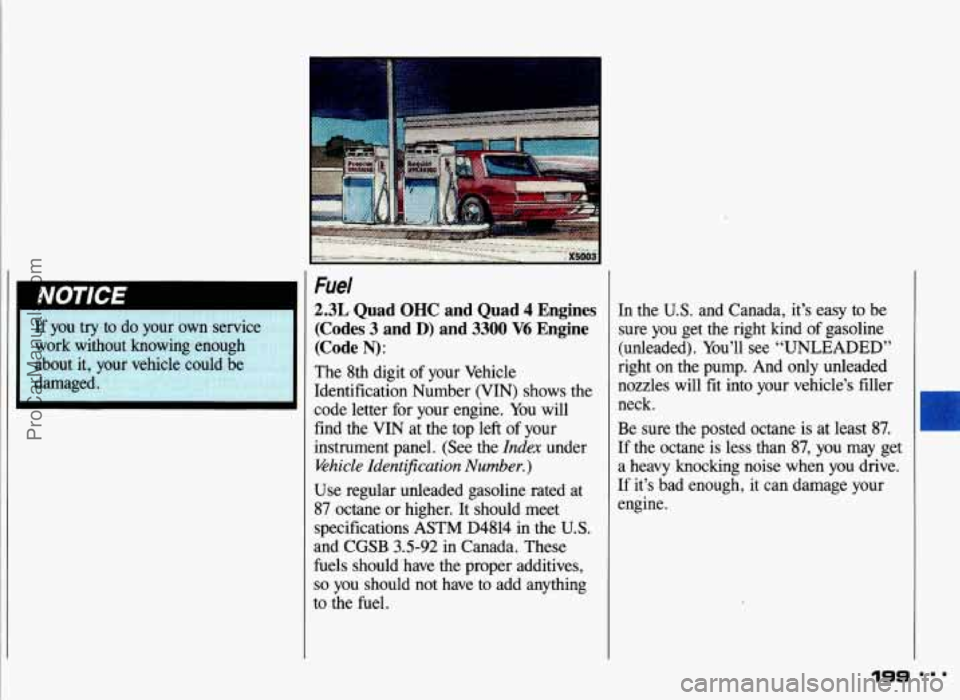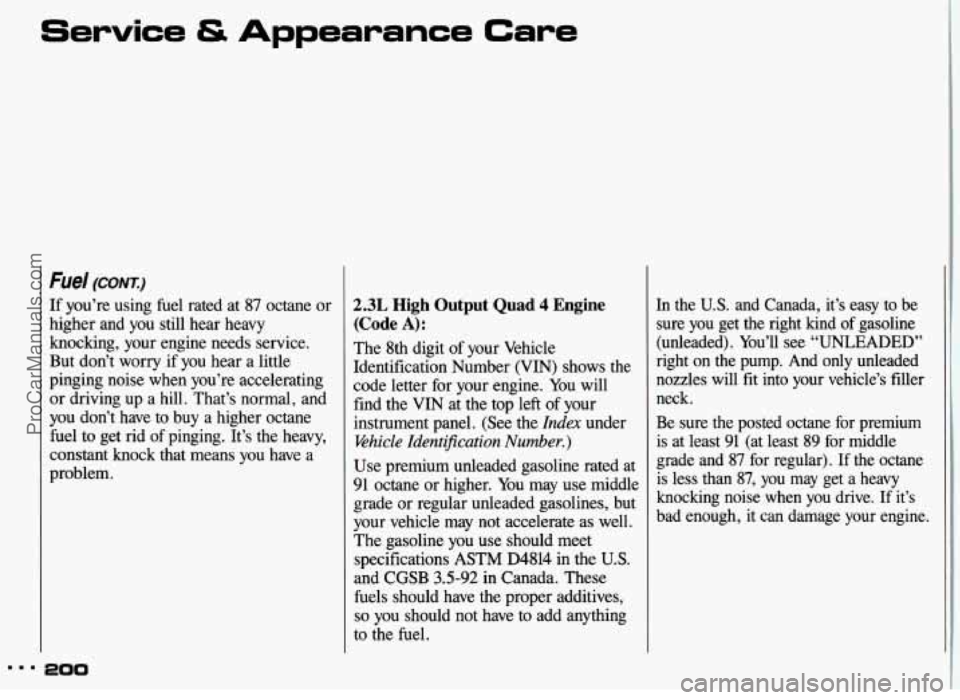1993 PONTIAC GRAND-AM fuel additives
[x] Cancel search: fuel additivesPage 200 of 306

Fuel
2.3L Quad OHC and Quad 4 Engines
(Codes
3 and D) and 3300 V6 Engine
(Code
N):
The 8th digit of your Vehicle
Identification Number (VIN) shows the
code letter for your engine. You will
find the VIN at the top left
of your
instrument panel. (See the
Idex under
&hicle Identijkation Number.)
Use regular unleaded gasoline rated at
87 octane or higher. It should meet
specifications ASTM D4814
in the U.S.
and CGSB 3.5-92 in Canada. These
fuels should have the proper additives,
so you should not have to add anything
to the fuel. In the
U.S. and
Canada, it’s easy to be
sure you get the right kind
of gasoline
(unleaded). You’ll see “UNLEADED”
right on the pump. And only unleaded
nozzles will fit into your vehicle’s filler neck.
Be sure the posted octane is at least
87.
If the octane is less than 87, you may get
a heavy knocking noise when you drive.
If it’s bad enough, it can damage your
engine.
19s
ProCarManuals.com
Page 201 of 306

Service & Appearance Care
Fuel (CONT.:)
If you’re using fuel rated at 87 octane or
higher and you still hear heavy
knocking, your engine needs service.
But don’t
worry if you hear a little
pinging noise when you’re accelerating or driving up a hill. That’s normal, and
you don’t have to buy a higher octane
fuel to get rid of pinging. It’s the heavy,
constant knock that means you have a
txoblem.
2.3L High Output Quad 4 Engine
(Code
A):
The 8th digit of your Vehicle
Identification Number
(VIN) shows the
code letter for your engine. You will
find the VIN at the top left of your
instrument panel. (See the
Index under
Rhicle ldentijication Number.)
Use premium unleaded gasoline rated at
91 octane or higher. You may use middle
grade or regular unleaded gasolines, but
your vehicle may not accelerate as well.
The gasoline
you use should meet
specifications
ASTM D4814 in the U.S.
and CGSB 3.5-92 in Canada. These
fuels should have the proper additives,
so you should not have to add anything
to the fuel.
In the U.S. and Canada, it’s easy to be
sure
you get the right kind of gasoline
(unleaded).
You’ll see “UNLEADED”
right on the pump. And only unleaded
nozzles will
fit into your vehicle’s filler
neck.
Be sure the posted octane for premium
is at least 91 (at least 89 for middle
grade and
87 for regular). If the octane
is less than
87, you may get a heavy
knocking noise when you drive.
If it’s
bad enough, it can damage your engine.
888 a00
ProCarManuals.com
Page 203 of 306

3
Gasolines for Cleaner Air
Your use of gasoline with detergent
additives will help prevent deposits from
forming in your engine and fuel system.
That helps keep your engine in tune and
your emission control system working
properly. It’s good for your vehicle, and
you’ll be doing your part for cleaner air.
Many gasolines are now blended with
materials called oxygenates. General
Motors recommends that you use
gasolines with these blending materials,
such as MTBE and ethanol. By doing
so, you can help clean the air, especially
in those parts of the country that have
high carbon monoxide levels. In
addition, some gasoline suppliers are
now producing reformulated gasolines.
These gasolines are specially designed
to reduce vehicle emissions. General
Motors recommends that you use
reformulated gasoline. By doing
so, you
can help clean the air, especially in
those parts of the country that have high
ozone levels.
You should ask your service station
operators if their gasolines contain
detergents and oxygenates, and if they
have been reformulated to reduce
vehicle emissions.
Fuels in Foreign Countries
If you plan on driving in another
country outside
the U.S. or Canada,
unleaded fuel may be hard to find.
Do not use leaded gasoline. If you use
even one tankful, your emission controls
won’t work well or at all. With
continuous use, spark plugs can get
fouled, the exhaust system can corrode,
and your engine oil can deteriorate
quickly. Your vehicle’s oxygen sensor
will be damaged. All of that means
costly repairs that wouldn’t be covered
by your warranty.
ProCarManuals.com
Page 296 of 306

Proper Mixture to Use ......... 221
Safety Warnings. About
........ .179. 181. 182. 183
Temperature Gage
............. 93
Temperature Warning Light ...... 92
Thermostat
.................. 223
Corrosion Protection
............ 246
Cruise Control
.................. 70
Cup Holders
................... 83
Curves. Driving
on .............. 136
Customer Assistance Information
. . 279
Daytime Running Lights
......... 75
Defects. Safety. Reporting Dead Battery: What to Do
........ 171
Defensive Driving
.............. 126
(see
Safety Defects)
Defogger. Rear Window .......... 105
Defogging Your Windows
.... .103. 105
Door Locks
.................... 45
Door. Remote Fuel Filler
......... 203
Downshifting
.............. .62. 152
Driver Position
.................. 18
Driving
....................... 121
AtNight
.............. ... 142 City
........................ 147
Controlling a Skid
............. 141
Defensively
.................. 126
Drunken
.................... 127
Freeway
.................... 148
Highway Hypnosis
............ 151
Hill and Mountain
............ 152
In a Foreign Country
.......... 202
In Fog, Mist and Haze ......... 146
In the Rain
.................. 144
Long Distance ................ 150
Loss of Control
............... 140
On Curves ................... 136
Passing
..................... 138
Skidding
.................... 141
Through Deep Standing Water
.... 55
Winter Driving
............... 156
With a Trailer
................ 164
Driving on
Snow or Ice .......... 156
Drunken Driving
............... 127
Easy-Entry Seat
................ 11
Electrical Equipment, Adding
............. .55, 107, 248
Emergencies, Braking
........... 135 Emergencies
on the
Road ......... 169
Emergencies. Steering in
......... 137
Emergency Starting
.............. 171
Emergency Towing
.............. 175
Engine Block Heater
......... .56, 213
Engine Coolant (see
CooZant)
Engine Coolant Temperature Warning
Engine Identification
........ .52. 247
Engine Oil
.................... 209
Additives
.................... 213
Checking
& Adding ........... 209
Disposing of Used Oil
.......... 214
Energy Conserving
............ 212
Filter
.................. .213. 257
Kind of Oil to Use ............. 210
Pressure Gage
................. 95
Warning Light
................ 93
When to Change .............. 213
Engine Overheating
............. 179
Engine Specifications
............ 256
Engine. Starting
................. 52
Automatic Transaxle
........... 53
Manual Transaxle
.............. 53
2.3L Quad 4 Engine
............ 53
3300
V6 Engine ............... 54
295
Light (see Coolant)
ProCarManuals.com